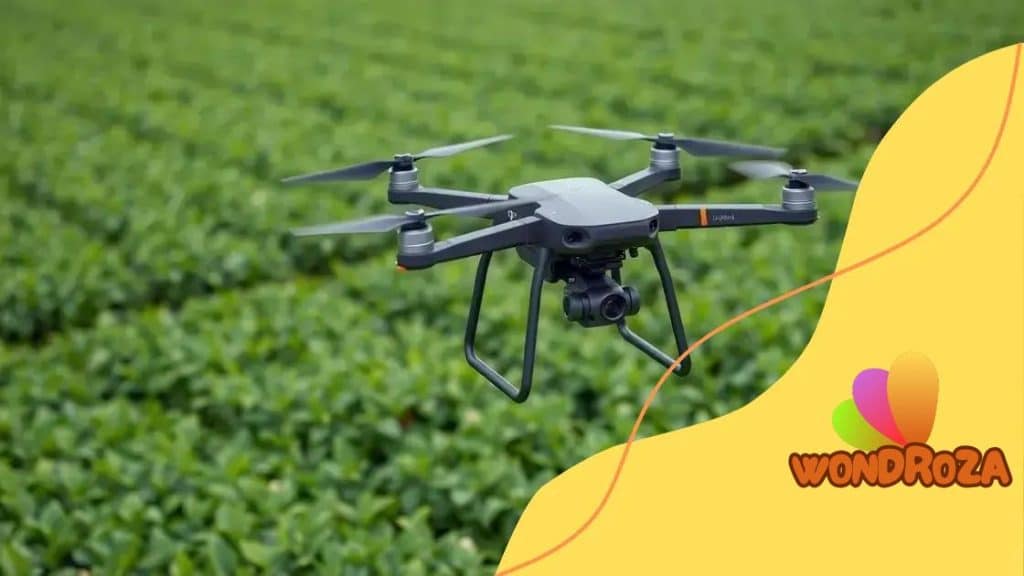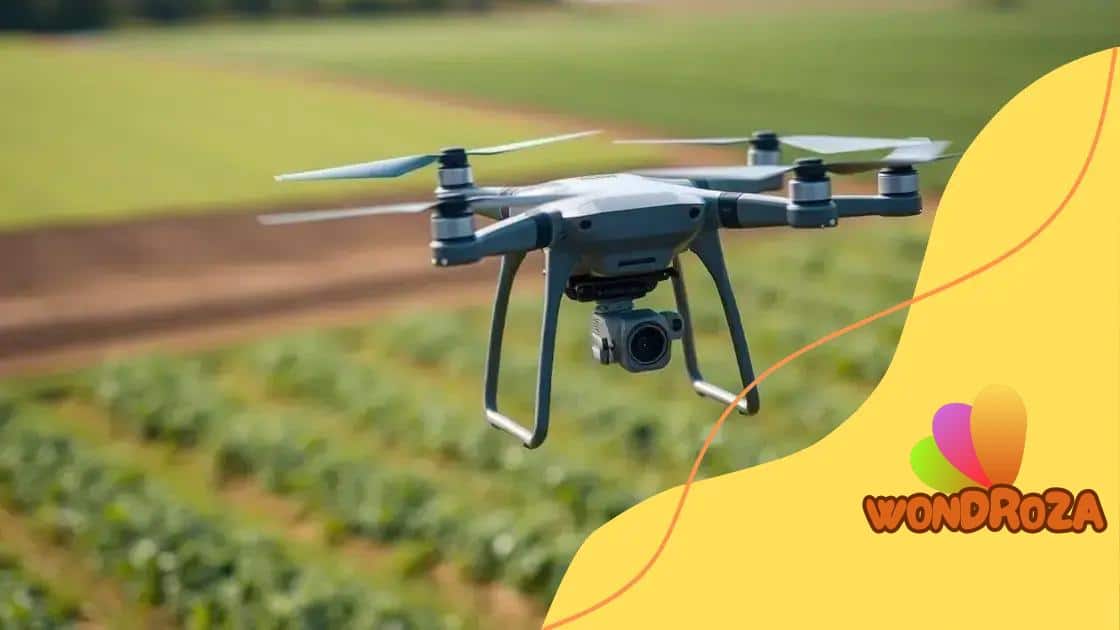How drones are revolutionizing agriculture worldwide

How drones are revolutionizing agriculture worldwide involves enhancing efficiency through precision monitoring, improving resource management, and promoting sustainable practices, ultimately leading to higher yields and smarter farming solutions.
How drones are revolutionizing agriculture worldwide is something worth exploring. Imagine a farmer equipped with the latest drone technology, able to monitor vast fields in real-time. Curious about how these flying devices are changing traditional farming methods?
Understanding drone technology in agriculture
Understanding drone technology in agriculture starts with knowing how these innovative tools operate. Drones, or unmanned aerial vehicles (UAVs), are equipped with advanced sensors and cameras that can collect vital data for farmers. By leveraging drone technology, agriculture can become more efficient and productive.
What Makes Drones Ideal for Farming?
There are several key features that make drones particularly effective in agricultural settings:
- Real-time data collection: Drones can quickly gather information about crop health and soil conditions.
- Precision mapping: Aerial images help farmers analyze their fields with high accuracy.
- Cost-effectiveness: Using drones can reduce labor costs and time spent on traditional surveying techniques.
As technology advances, drone capabilities are expanding rapidly. Today’s drones are capable of performing complex tasks such as planting seeds and applying fertilizers. This not only improves efficiency but also helps reduce the overall environmental impact of farming practices.
How Drones Improve Crop Monitoring
Through the use of multispectral sensors, drones can assess plant health by detecting infrared light reflected from crops. This data helps farmers identify which areas of their fields may need attention, such as additional water or nutrients. Moreover, drone imagery enables real-time monitoring of pest infestations and disease spread, allowing for timely interventions.
As farmers begin to understand the potential of drone technology, they recognize its role as a valuable ally in achieving agricultural sustainability. This shift toward technology-driven farming not only enhances yields but also promotes a more responsible approach to resource management.
Overall, understanding drone technology is essential for modern agriculture. By adopting and integrating these innovations, farmers can not only increase their productivity but also adapt to the ever-changing challenges in the agricultural landscape.
Benefits of using drones for crop monitoring
The benefits of using drones for crop monitoring are significant and transformative. Drones help farmers collect data and analyze their fields in real-time. This ability leads to better decision-making and improved yield.
Enhanced Data Collection
Drones can gather a variety of data types, which helps to assess crop health efficiently. This data includes:
- Multispectral imaging: This technology allows drones to capture data beyond normal human vision, helping to identify plant stress.
- Thermal imaging: Drones with thermal cameras can detect temperature variations in crops, identifying areas that need irrigation.
- High-resolution aerial imagery: Farmers can analyze detailed images to monitor growth patterns across their fields.
Using this collected data, farmers can promptly react to issues such as pests or diseases. With real-time insights, they can target specific areas instead of treating entire fields.
Improved Resource Management
Resource management is crucial for sustainable agriculture. Drones allow farmers to optimize input usage, such as water and fertilizers. By applying resources precisely where needed, they can:
- Reduce waste: Targeted applications cut down on excess chemicals.
- Save costs: Less waste translates to lower expenses for farmers.
- Minimize environmental impact: Thoughtful resource usage helps protect surrounding ecosystems.
This smarter approach to farming creates a sustainable cycle that not only benefits the farmer but also contributes to environmental health.
Furthermore, drones can enhance crop monitoring by ensuring timely interventions. For instance, if a farmer notices a decline in crop health through drone imagery, action can be taken immediately, resulting in higher yields and reduced economic losses.
Overall, the advantages of using drones for crop monitoring are substantial. Farmers who embrace this technology are at an edge, navigating challenges with ease and efficiency. By leveraging the benefits that drones offer, they can ensure the health of their crops and boost farm productivity.
Drones for precision agriculture and data collection

Drones for precision agriculture and data collection are changing how farmers work their fields. These high-tech tools are designed to maximize efficiency by providing essential information quickly and accurately.
The Role of Drones in Precision Agriculture
Drones allow farmers to execute precision agriculture by collecting data that matters. This technology enhances crop management by offering insights that help with:
- Soil analysis: Drones can assess soil health, helping farmers understand nutrient levels and moisture availability.
- Crop health monitoring: With cameras and sensors, drones can identify which crops are thriving and which ones are struggling.
- Field mapping: Drones create detailed maps that show changes in terrain, helping farmers plan their planting and harvesting strategies.
Using aerial imagery, farmers can see their fields from a bird’s-eye view. This perspective helps them make informed decisions, ensuring they address issues before they escalate.
Data Collection Capabilities
The data collected by drones is invaluable. With the ability to capture images in various wavelengths, farmers can gain insights into crop health and overall farm performance. For instance, multispectral imaging helps detect stress in plants that the naked eye might miss. This can lead to quicker interventions and healthier crops.
Moreover, drones can measure environmental conditions, such as temperature and humidity, providing a more comprehensive overview of how these factors impact crop growth. Using these insights, farmers can adjust their practices to better suit their crops’ needs.
As the agricultural industry continues to embrace technology, drones serve as essential partners. By enabling better decision-making through precise data collection, farmers can enhance productivity and sustainability in their operations.
Investing in drone technology for precision agriculture not only elevates farm efficiency but also contributes to achieving higher yields. Farmers leveraging these advancements position themselves for success in the ever-evolving agricultural landscape.
The role of drones in sustainable farming practices
The role of drones in sustainable farming practices is becoming increasingly important as agriculture faces environmental challenges. Farmers are adapting their techniques to promote sustainability, and drones are at the forefront of this movement.
Enhancing Resource Efficiency
Drones help farmers use resources more efficiently, which is key to sustainable agriculture. By providing detailed insights into field conditions, drones enable farmers to:
- Reduce water usage: Drones can identify areas that require irrigation, allowing farmers to water only where needed.
- Optimize fertilizer application: With accurate data on soil health, farmers can apply fertilizers in targeted zones rather than uniformly across entire fields.
- Minimize pesticide use: Drones can spot pest infestations early, which means farmers can treat only affected areas.
This precision not only conserves inputs but also reduces waste, which is essential for a more sustainable approach to farming.
Promoting Biodiversity
Another significant benefit of using drones is their ability to support biodiversity. By helping to monitor the environment, drones assist farmers in maintaining healthy ecosystems. They can assess the impact of agricultural practices on local wildlife and help identify areas that require conservation efforts.
Drones also support practices like cover cropping and crop rotation. For instance, drones can monitor cover crops, ensuring they provide habitat for beneficial insects. This leads to healthier soils and reduces the need for chemical inputs.
As a result, farmers using drones can make informed decisions that align with sustainable farming practices. By focusing on biodiversity, they promote a balanced ecosystem that benefits both crops and wildlife.
Furthermore, drones enable farmers to gather data on the long-term impacts of their practices. This data can reveal trends over time, allowing for adjustments in methods that align with both productivity and sustainability.
In summary, the role of drones in sustainable farming practices is vital. By embracing technology, farmers can enhance their resource management, promote biodiversity, and adapt their methods for a more sustainable future.
Future trends of drones in the agricultural sector
The future trends of drones in the agricultural sector promise exciting advancements that could reshape how farming is done. As technology evolves, drones will play an even more significant role in enhancing agricultural practices.
Increased Automation
One of the most notable trends is the push towards increased automation. In the coming years, we can expect drones to work alongside other automated systems. This synergy allows for:
- Autonomous flying: Drones will operate without human intervention, performing tasks like crop spraying and monitoring.
- Data integration: Agricultural drones will connect with farm management software, providing real-time data analysis.
- Diverse tasks: Future drones might handle a variety of farming activities, including planting seeds and assessing crop health.
These advancements will streamline operations and make farming more efficient.
Enhanced Data Analytics
As drones become more sophisticated, their ability to collect and analyze data will improve significantly. Future drones will utilize artificial intelligence (AI) and machine learning to:
- Identify patterns: Analyzing historical data to detect trends in crop yields and conditions.
- Predict outcomes: Using algorithms to forecast future crop performance based on current data.
- Offer tailored advice: Providing specific recommendations for crop management based on detailed analysis.
With enhanced data analytics, farmers can make better decisions that lead to greater yields and sustainability.
Integration with IoT
The Internet of Things (IoT) will also influence the use of drones in agriculture. As more devices become connected, drones will play a vital role in gathering and transmitting data across various components of a farm. This integration means:
- Smart farming: Drones will work alongside sensors and other IoT devices to monitor conditions continuously.
- Real-time updates: Farmers will receive instant data about weather, soil moisture, and crop health.
- Improved efficiency: Through data sharing, farmers can optimize resources in real time.
The future of drones in agriculture holds promise for more efficient, data-driven farming practices. By embracing these innovations, farmers can adapt to changes in climate, market demands, and technological advancements, ensuring sustainable food production for generations to come.
FAQ – Frequently Asked Questions about Drones in Agriculture
How do drones help in crop monitoring?
Drones provide real-time data about crop health, allowing farmers to identify problems like pests or diseases quickly.
What are the benefits of using drones for precision agriculture?
Drones improve resource efficiency by enabling targeted irrigation and fertilizer application, reducing waste and costs.
Will drones increase productivity on farms?
Yes, drones streamline farming operations and provide critical insights that can lead to higher crop yields.
How are drones contributing to sustainable farming?
Drones promote sustainable practices by reducing chemical usage and helping farmers monitor biodiversity on their farms.





